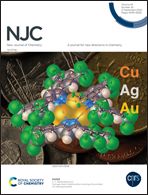PLGA-nanoparticles loaded with a thiosemicarbazone derived palladium(ii) complex as a potential agent to new formulations for human ovarian carcinoma treatment
Abstract
The complex named triphenylphosphane-chlorido(pyrenecarboxaldehyde-N(3)-cyclohexyl-thiosemicarbazonate)palladium(II), [PdCl(PPh3)(PrCh)], has been recently selected as a promising cytotoxic agent against resistant ovarian cancer cells owing to its inhibitory effect on the topoisomerase IB enzyme. In order to increase the efficacy of this promising drug, in the present work the influence of the encapsulation process of the PdII complex in the poly(lactic-co-glycolic acid) (PLGA) polymer was studied. PLGA nanoparticles containing the PdII complex (NPs-PLGA-PdII) were prepared by using an emulsion-solvent evaporation technique and fully characterized by using DLS and SEM. The results showed that the NPs-PLGA containing the PdII complex can be obtained successfully through an emulsion-solvent evaporation method with a high encapsulation efficiency (96%). Furthermore, the NPs-PLGA were revealed to be suitable as a controlled release carrier system for [PdCl(PPh3)(PrCh)], since in vitro tests displayed a slow and sustained release of the PdII complex. After PdII encapsulation in NPs-PLGA, biological studies were assayed by using the OVCAR3 cell line (human ovarian carcinoma cells). The study of cytotoxicity by resazurin assay showed that the formulation led to a significant reduction of the ovarian cell viability (80% at 1 μM), which was more than that achieved with the non-encapsulated complex or cisplatin. Most notably, the relevant cytotoxicity of NPs-PLGA-PdII against the cisplatin resistant cell line used in this work must be highlighted since resistance is one of the major challenges in chemotherapy.



 Please wait while we load your content...
Please wait while we load your content...